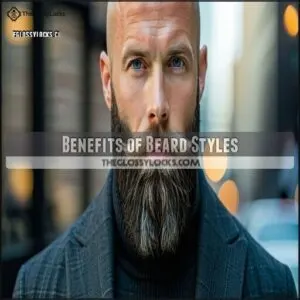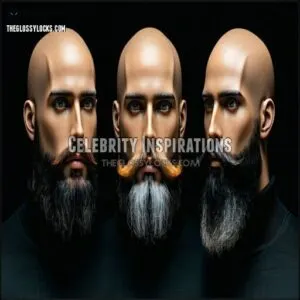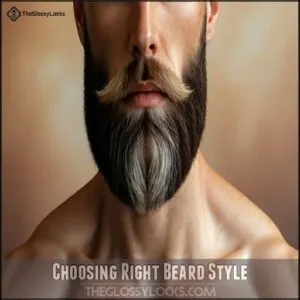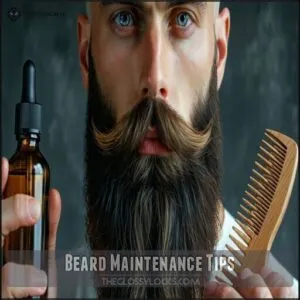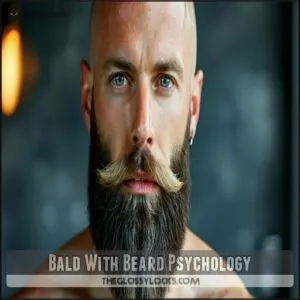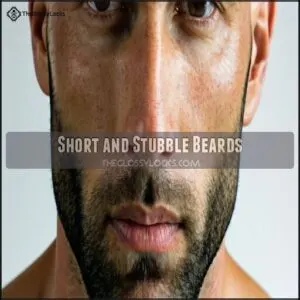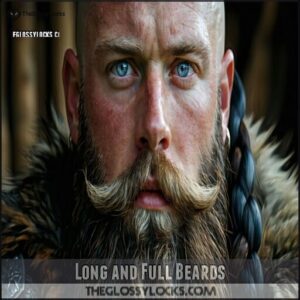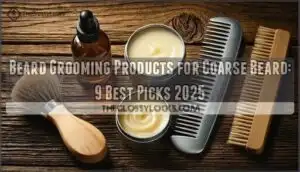This site is supported by our readers. We may earn a commission, at no cost to you, if you purchase through links.
 You’ll find that bald with beard styles create a striking balance that commands attention.
You’ll find that bald with beard styles create a striking balance that commands attention.
The classic full beard adds definition to your jawline, while a short boxed beard offers a clean, professional look.
If you’re after something bolder, try the Viking-inspired longer beard or the Van Dyke for artistic flair.
Your face shape matters—oval faces handle most styles well, while round faces benefit from angular, longer beards.
Don’t forget that maintenance is non-negotiable; even the perfect beard style falls flat without proper care.
The right combination isn’t just about looking good—it’s about wearing your confidence like a well-tailored suit.
Table Of Contents
- Key Takeaways
- Beard Styles for Bald Men
- Choosing Right Beard Style
- Beard Maintenance Tips
- Bald With Beard Psychology
- Beard Style Variations
- Frequently Asked Questions (FAQs)
- Are beard styles for bald men still in style?
- Which Beard styles go well with a bald head?
- What is a full beard with a bald head?
- How to choose a beard for a bald guy?
- How to blend a beard with a bald head?
- Does a bald man have a beard?
- Does a beard look good with a bald head?
- Are bald men highly sexed?
- What is the best beard length for a bald head?
- How to keep a beard with a bald head?
- Conclusion
Key Takeaways
- Your face shape determines your ideal beard style—oval faces work with most styles while round faces benefit from longer, angular beards that add definition.
- You’ll need to match your beard style to your hair type, as coarse hair supports fuller looks while fine or patchy growth works better with shorter styles like stubble or goatees.
- You can’t skip maintenance if you want your beard to enhance your bald look—regular trimming, proper neckline definition, and daily moisturizing are essential for a polished appearance.
- You’re making a psychological statement with your bald and beard combination that goes beyond fashion—it demonstrates confidence, challenges stereotypes, and expresses your individuality.
Beard Styles for Bald Men
If you’re bald, growing a well-chosen beard can redefine your look while highlighting your best features.
With the right style, you’ll strike a balance that’s both bold and effortlessly cool.
Benefits of Beard Styles
A beard isn’t just facial hair—it’s a personal style statement.
It offers a confidence boost, accentuates a masculine appearance, and creates a stylish edge.
Consider these benefits:
- Facial Definition: Beards frame your face and balance features.
- Confidence Boost: Focus shifts from baldness to intentional grooming.
- Masculine Appearance: Exudes strength and boldness.
- Stylish Edge: Elevates your look effortlessly.
- Personal Expression: Showcases individuality through unique beard styles.
Celebrity Inspirations
Want proof that bald with beard styles embody boldness? Look at iconic bald celebrities.
Jason Statham’s neat stubble exudes strength, blending sharp grooming with rugged charisma. Then there’s Dwayne Johnson, whose goatee stands as a beacon of simplicity, precision, and masculine confidence.
Idris Elba? His crisp, full beard sets the bar for elegance and polished charm. These beard style trends go beyond Hollywood—they’re practical inspiration for you.
Recreating celebrity looks isn’t just about copying; it’s about using celebrity grooming secrets to craft a timeless, personal style. Start your beard evolution today!
Choosing Right Beard Style
Choosing the right beard style starts with understanding your face shape and how different styles can enhance your features.
You’ll also want to take into account your hair type, daily routine, and how much time you’re willing to spend on maintenance.
Face Shape Considerations
Your face shape plays a big role in a beard’s impact.
For round faces, goatees or pointed beards add sharpness. Oblong faces benefit from balanced styles like short beards to avoid elongation.
Fuller sides soften square faces, while diamond face shapes shine with narrower sides and broader chins.
Balance is everything—match your skull shape and beard for a polished look. The wrong style? It’s like wearing mismatched socks.
Hair Type Considerations
When choosing beard styles for bald men, consider your hair type.
Coarse hair works well for fuller, rugged looks, while fine hair suits shorter, precise styles.
For patchy growth or a slower beard growth rate, stubble or goatee styles add balance.
Thick or curly beard textures support bolder, creative looks, enhancing the classic beard and bald head combination.
A thin beard may be linked to inherited genetic factors.
- Coarse: Fuller, rugged beards
- Fine: Neater, shorter styles
- Patchy growth: Goatees or stubble
- Thick or curly: Bold, voluminous options
Lifestyle Considerations
A great beard style aligns with your daily swing. Busy schedule? Go for low-maintenance stubble—it’s quick and classic.
For demanding job interviews or formal gigs, stick with polished, professional designs that exude confidence and masculine power.
Traveling requires portable grooming tools. Your beard can elevate your dating game, gain social acceptance, and even complement seasonal adjustments—all while fitting seamlessly into your life and personal style, which can be a great way to show your confidence.
Beard Maintenance Tips
Keeping your beard sharp requires consistent care, but it doesn’t have to be complicated.
With the right tools and routine, you can maintain a clean, polished look that complements your bald style effortlessly.
Trimming and Shaping
A sharp beard needs proper trimming and shaping to stand out.
Start with neckline definition and cheek lines—these create beard symmetry and a clean look. Use quality shaping tools like scissors or a trimmer for precision based on your hair texture.
Achieving the perfect shape requires the right beard grooming supplies.
Incorporate these four steps for smooth maintenance:
- Keep your neckline neat and natural.
- Shape cheek lines evenly for balance.
- Choose reliable trimmer selection tools.
- Trim regularly to match your beard style.
Common Mistakes to Avoid
Neglecting neckline definition or uneven trimming can make your beard look careless, not confident. Always shape precisely and trim gradually—over-trimming risks a patchy beard, killing its appeal.
Skipping moisturizing leads to dull, itchy growth, so use beard oil daily. To avoid skin irritation, consider pre-shave exfoliation.
Avoid cheap, wrong products; high-quality ones aid beard grooming and maintenance. Unsuitable styles disrupt balance—match your beard shaping with your face.
Consistent care guarantees your look stays sharp, polished, and ready to command attention effortlessly.
Bald With Beard Psychology
Pairing a beard with a bald head isn’t just about style—it’s also a way to reshape how you see yourself and how others see you.
This combination reflects confidence, individuality, and the ability to challenge outdated stereotypes with ease, embodying a sense of individuality.
Confidence Boosters
A bald head with a beard isn’t just stylish—it’s a confidence boost.
The beard and bald head combination emphasizes a masculine image and enhances attractiveness.
Here’s how to elevate your look:
- Craft Your Style: Pick beard styles for bald men that show off your personality.
- Commit to Grooming: Keep it neat with regular trims for a polished, professional vibe.
- Focus on Positivity: Embrace the bald with beard look as a positive transformation, showcasing self-perception and style expression boldly.
Embracing Individuality
Beards on bald men aren’t just about looks—they’re your signature.
With bald with beard styles, you embrace self-acceptance and defy norms unapologetically.
From sleek goatees to bold full beards, your choice reflects confidence.
Unique grooming isn’t about trends—it’s personal expression.
The bald with beard look sends a message: you own your style, your narrative, your rules.
Overcoming Stereotypes
Breaking baldness stigmas starts with redefining masculinity and embracing the beard and bald look.
Society’s outdated views on hair and confidence don’t hold up when you make bold choices. Bald with beard styles redefine age perception and gain professional acceptance.
It’s worth noting that beards are often seen as signals of maturity.
- Media portrayal: Celebrities proudly rock the bald and beard combo.
- Confidence: Owning your look shows strength.
- Masculinity redefined: Focus shifts from hair loss to character.
Beard Style Variations
You’ve got plenty of options in the area of beard styles, whether you prefer low-maintenance stubble or a statement-making long beard.
Each style offers unique ways to complement your bald look and enhance your features.
Short and Stubble Beards
Short beards, like stubble, are a go-to for stubble attractiveness and everyday ease.
A well-maintained short beard highlights your jawline and offers rugged charm. Use regular trimming to keep it clean—short beard upkeep is straightforward but essential.
Stubble goatees are another classic option, blending style and workplace appropriateness. For patchy areas, fill them in strategically or embrace the natural look.
These beard styles for bald men perfectly balance effortlessness with boldness, complementing a bald head beard style. Achieving the perfect stubble often requires a specialized trimming tool.
Long and Full Beards
A long, full beard paired with a bald head is a classic power move. This bold combination adds structure to your face and grabs attention.
Beard length and density can be customized to suit your face shape, making it one of the most versatile beard styles for bald men. Popular choices like Viking and lumberjack beard styles create a rugged, confident look.
Regular maintenance, like trimming and using beard oil, keeps your beard healthy and sharp. To maintain a healthy beard, consider using quality beard products.
With proper care, these beard styles for a bald head speak volumes about your style and charisma.
Unique and Creative Styles
Looking to amplify your style? Transform your bald head with bold and unique beard styles.
Experiment with beard art, like patterned shaves or colored beards, to add flair. Try a braided beard for rugged elegance, or accessorize with beard jewelry for a dazzling twist.
Feeling theatrical? Grow a French Fork or a grizzly-inspired beard. These creative choices let your bald look shine while showcasing personality, originality, and confidence.
To maintain such styles, remember that regular trimming is necessary for a balanced look.
Frequently Asked Questions (FAQs)
Are beard styles for bald men still in style?
According to a 2023 study, 74% of women find bald men with beards more attractive than clean-shaven bald men.
Yes, beard styles for bald men remain fashionable, complementing your look while adding masculine dimension.
Which Beard styles go well with a bald head?
Full beards, stubble, goatees, and pointed styles complement your bald head perfectly.
You’ll find that a well-groomed beard balances your features and adds masculine edge while drawing attention from hair loss.
What is a full beard with a bald head?
Jason Statham rocks the full beard with his bald head, creating a powerful contrast.
Your full beard completely covers your face from sideburns to chin, adding dimension and masculinity while balancing your smooth dome.
How to choose a beard for a bald guy?
Consider your face shape first – round faces benefit from angular beards while square faces work with rounder styles.
Match beard density to your features and lifestyle, and don’t forget regular maintenance for a polished look.
How to blend a beard with a bald head?
To blend your beard with a bald head, gradually fade the sideburns into your scalp using a trimmer with decreasing guard sizes.
Maintain clean necklines and cheek lines for a polished, seamless shift.
Does a bald man have a beard?
70% of bald men choose to grow beards to enhance their look.
You can absolutely rock a beard while bald – it often creates a balanced, masculine appearance that many find attractive and confident-looking.
Does a beard look good with a bald head?
A beard absolutely complements a bald head by creating visual balance and drawing attention to your face.
You’ll exude confidence and masculinity while having endless style options to showcase your personal aesthetic.
Are bald men highly sexed?
Myths and misconceptions abound, but there’s no scientific evidence linking baldness to higher sex drive.
Your hormone levels and individual biology determine your libido, not your hairline.
Everyone’s different in this department, with biology playing a significant role.
What is the best beard length for a bald head?
The ideal beard length for your bald head ranges from stubble (2-5mm) to medium length (10-20mm), depending on your face shape.
You’ll want enough growth to create contrast without overwhelming your features.
How to keep a beard with a bald head?
Like a garden requires tending, your beard needs daily maintenance.
Keep it clean with beard shampoo, apply oil to moisturize,
trim regularly with a quality trimmer, and define neck/cheek lines for a polished look.
Conclusion
The world’s most powerful transformation awaits in finding your perfect bald with beard style.
You’ll discover it’s more than fashion—it’s a statement of confidence and authenticity.
Consider your face shape, lifestyle, and personality when selecting your signature look.
With proper maintenance and the right products, your bald with beard style will elevate your appearance to new heights.
Remember, the best style isn’t just what’s trending—it’s what makes you feel unstoppable every time you look in the mirror, and it’s about finding a look that reflects your authenticity.

